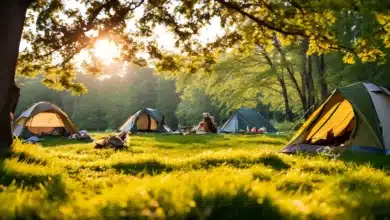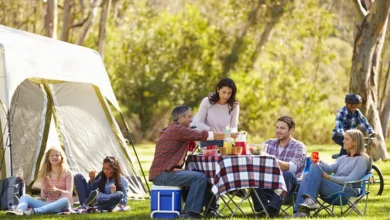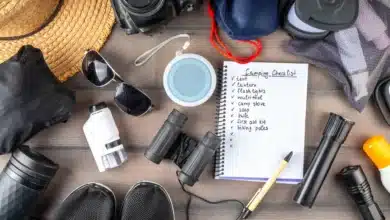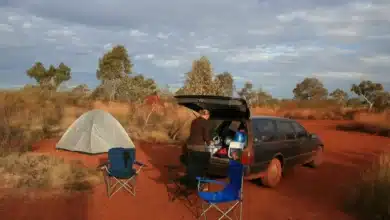The Best Food for Winter Camping
The Best Food for Winter Camping
Food is one of the most important and fun parts of camping. Well, at least the eating part. Now, if you’re car camping or camping in a cabin, you can pretty much bring anything you want, granted it won’t freeze. If you’re doing any hiking, especially backpacking, you’ll want to take more consideration to the type of food you’ll be bringing, mostly for weight and fuel savings. If you’re pulling a sled, you’ll have some more flexibility.
In this article, I’ll be talking about some of the best foods to bring winter camping and how to prepare them. Keep in mind, these are suggestions and food choices will depend on the type of camping you’ll be doing and temperature.
How Many Calories Do I Need in the Winter?
During the winter, you’re going to need a lot more extra calories for two reasons. One, you’ll be doing a lot more work, like carrying heavier gear and trekking through snow. You might even be pulling a sled through rough terrain. This activity will burn a ton of calories, even more than compared to summer hiking. And second, you’ll be burning more calories to stay warm when you aren’t doing activity, including sleeping.
So how many calories do you need for winter hiking? At a minimum, plan on at least 4000 calories per person per day. Some people recommend 5,000 to 6,000 calories. It all depends on your body type and activity level. This equates to about 2-2.5 lbs of food per person per day. If you are using freeze-dried food, this weight will be less. If you’re doing more intense activity, then plan on more calories. It’s better to plan more than you think you need. And if you’re worried about gaining weight while hiking in winter, don’t even worry about it.
One of the challenges to getting enough calories is actually consuming it. Eating upwards of 6,000 is a lot more than your typical day, which means you might need to be constantly eating throughout the day and even when you don’t feel hungry.
What Is a Good Carb, Protein, and Fat Ratio?
As a guideline, you’ll want to have your caloric intake broken down into the following parts:
- 50% Carbohydrates
- Simple carbohydrates are carbohydrates from starches and sugars that provide immediate energy. Some examples are candy bars, fruits, and syrups.
- Complex carbohydrates provide energy but at a slower rate than simple carbohydrates. These foods are grains, beans, cereals, and pasta.
- 20% Protein
- Proteins are important for maintaining cell health and muscle growth.
- Provide slower, long-term energy.
- Found in foods such as meat, cheese, milk, grains, beans, and nuts.
- 30% Fats
- Fats take the longest to metabolize, providing long-term energy.
- Packed with calories – more than twice as many calories per pound than carbohydrates and proteins, making them great for winter hiking and camping.
- These types of foods are oils, butter, nuts, cheese, and meats such as salami, pepperoni, and sausage.
Getting enough vitamins is important too, but as long as you eat a variety of meals, you’ll be okay. If you are taking an extended trip, it might not be a bad idea to bring some supplements, especially if your meals aren’t varied.
You may also like Most Efficient Camping Stoves
What Are the Best Foods for Winter Camping?
There are a lot of different kinds of food you can bring to winter camping. A lot of it comes down to personal preference and experience. I’ve seen people have success with bringing eggs on overnight trips, which a lot of people avoid altogether. It all depends on your goals and what you are comfortable with.
Foods to Avoid
There are a few important tips when picking the right foods for winter camping. Generally, any food with a lot of water content should be avoided, such as fruits and vegetables. Fresh foods like eggs and rice should be avoided as well. All of these foods are bound to freeze and are heavier to carry because of their water weight.
There are some fresh foods that are okay to bring in the winter. Foods like butter, cheese, cookies, and brownies, and some meats like salami and pepperoni.
Still, some foods with little water content can still freeze if it gets cold enough. If you have any food that you wish to eat on the go, keep it close to your body. There have been a few times I have gone for a cliff bar on a cold hike only to find it frozen solid. Keeping food in the inside pocket of your shell or fleece jacket will prevent it from freezing.
Dry Foods
Now that we know which foods to avoid for your winter hike, which foods should we bring? One way is to bring dry or dehydrated food. Dry foods are foods that have almost all the water removed from them. Preserving food by dehydration has been around for thousands of years, and it works because it prevents the growth of bacteria in the food. Not only does the food last longer, but it’s a great way to save weight when traveling.
Dry foods are foods like:
- Pasta
- Instant mashed potatoes
- Instant rice
- Dehydrated eggs
- Granola
- Pancake mix
- Dehydrated meats and fruits
You can make your own dehydrated foods at home using a food dehydrator. It takes some time, but for some, it’s a fun hobby. Dehydrators are fairly cheap, costing less than $100 for a unit. Check some of them out on Amazon.
Freeze-dried foods
Freeze-dried foods are an even more convenient way to bring meals on the trail. The difference between freeze-dried food and dehydrated food is the process in which both types of food undergo to remove water. Freeze-dried foods are first flash frozen, then moisture is removed in a vacuum chamber. The ice is then evaporated. All of this is done in a way that preserves the foods color, shape, size, and taste. Unlike using a food dehydrator which uses heat to remove moisture, nearly all the food’s nutritional value is saved.
Freeze-dried foods:
- Weigh less (less water weight)
- Are higher quality (keeps color, shape, size, and taste)
- Have high nutritional value (not damaged by heat)
- Can last up to 30 years
Another huge advantage of using freeze-dried foods over other camping foods is how easy they are to make. Just add water, and you’re good to go, no cooking! And you’ll save fuel in the process by not having to boil water as long.
You may also like How Much Is a Bundle of Firewood?
How Do I Prepare and Pack Winter Camping Meals?
When it’s dark and cold and you’re tired, preparing meals is one of the last things you want to do in the wilderness. And in the winter time, everything takes twice as long to do compared to summer. Preparing winter meals are home ahead of time can make things a whole lot easier when you’re out in the field.
Anything that can be prepared beforehand should be.
Some things you want to make sure you are planning:
- Meal planning – what meals will you be having for breakfast, lunch, and dinner, and on what days?
- Calories – Is everyone in your group getting enough calories every day?
- Labels – Is everything properly labeled? Distinguishing food and ingredients in the dark can be tricky.
- Meals prepped – Are meals prepped? Example – sandwiches made, cheese pre-sliced, ingredients pre-mixed.
A lot of space and some weight can be saved by taking all the food out of their boxes and moving them into baggies. The baggies should be durable enough so they don’t rip, and be easily opened and closed. Bringing extra baggies is always a good idea. Be sure to save any cooking instructions you may need and keep it inside the bag. Then, label each bag with what’s inside with a sharpie. It helps if the labels are big and bold to be seen easier in the dark.
An easy way to pack the food is to put each meal type in its own stuff pack. For example, all the breakfast meals will go into one stuff pack, while all the lunch and dinner in another. You might even want to label which meals you have on which day, such as “Dinner Day 2”.
Winter Camping Food Ideas
The food list below will help you plan your next winter camping or hiking trip. While these foods are great for winter, many of them are great for summer trips as well, as they are lightweight and full of calories. These are just suggestions. Experiment and find out what’s best for you. See the list below for some of the best winter camping foods.
You may also like Does Camp Fuel Go Bad? Does White Gas Have a Shelf Life?
Breakfast
Ah, we all know those cold mornings of not wanting to leave our cozy bed. Breakfast shouldn’t be too complicated but you’ll also want to make sure you are getting enough calories to fuel you throughout the day. You’ll want to make simple meals so you’re not sitting in the cold and wasting daylight.
For breakfast, you don’t want to have too much sugar to prevent crashing. Try to keep to the ratios mentioned above, where most of your calories come from complex carbohydrates. You’ll want to have foods that keep your energy levels steady throughout the day.
Hot cocoa, coffee, and tea
Warming up in the morning with a warm cup of coffee is one of the best ways to start the day. Coffee wakes you up, but it’s also a way to appreciate where you are and spend quality time with those who you are with. Coffee just touches the soul.
Hot drinks are such a small thing to carry that work like magic. There’s no real reason not to carry them. Even if you are a “minimalist”, you’ll be thankful for the coffee 🙂
While coffee and tea don’t have many calories, hot cocoa can have upwards of 200 calories per package. Hot cocoa can also be used for emergencies to treat hypothermia in the field.
Powdered fruit drinks
I’m not a huge fan of flavored fruit drinks in general (camping or not), but if you are, powdered fruit drinks are an easy way to fix that sweet craving you get after a long day of hiking. There are many different kinds depending on what you are looking for. Some have sugar, some don’t. Some are “sporty”, meaning they help replenish electrolytes.
Cereals and granola
Cereals are really simple to prepare and can even be eaten dry. Adding nuts and dried fruit adds a bit of variety and calories. Dried milk is actually not bad and can be brought along in a ziplock baggy
Hot cereal is also great and another excuse to have something warm in the morning.
Oatmeal
Oatmeal is something that I always bring on my backpacking trips. You can buy them in variety packs to keep things interesting and add your own fruits, honey, syrup, or whatever else you choose.
My recommendation is you buy the oatmeal that comes in the little paper pouches. The pouches are lined with wax. When you are hiking, you can just add a little water and eat right out of the pouch. Grab a spoon and you are good to go.
Dried milk
Dried milk is something you can add to a lot of meals, whether it be cold or hot cereal, mac and cheese, hot cocoa, or just drinking it on its own. Just add some water and you’re all set.
Dried Fruit
Dried fruit can be added to cereal, and oatmeal, and is just plain yummy to munch on. I like to have a little bit of variety such as apple slices, apricots, banana slices, berries, pineapple chunks, and strawberries.
Pancakes
Pancakes are a fun meal to cook while backpacking, and they can be cooked in a bunch of different ways. The easiest way to cook pancakes while hiking is to get a pancake mix that only requires water. Krusteaz pancake mix is a great option (check it out on Amazon).
You can bring different ingredients along and mix them inside a ziplock bag. Ingredients like freeze-dried berries, sugar, and chocolate chips will make some awesome pancakes when camping. You can add some regular butter or peanut butter to top it off.
Don’t be afraid of having leftovers either. You might even want to make extra to bring on the trail to munch on for later.
Muffins
Baking muffins in the backcountry, like pancakes, offer a lot of yummy variety. Carry some muffin mix in a baggy and pour the mix into paper or reusable silicone baking cups. Silicone baking cups are awesome. They don’t get damaged in your pack and are waterproof. They are reusable, durable, and easy to clean. Muffin removal is much easier too. Go ahead, and check them out on Amazon.
Steam baking is one method to bake muffins on the trail and can take less than 10 minutes to bake. The idea is to place the muffins on top of a holder inside a pot with a little bit of water. Cover the top and let the water steam to bake the muffins. Another option for baking in the wilderness is to use an outback oven.
Bannock bread and scones
Bannock bread is the bread of camping. In fact, it originates from Scotland and was later adopted by the Inuits of Alaska Canadians and Native Americans. Bannock bread uses simple dry ingredients and is cooked in a variety of ways, including over an open fire. Add raisins, berries, nuts, and even cheese and meats along with butter, spices, and honey.
Sausage, bacon, and ham
One of the advantages of winter camping is food stays fresh longer. Feel free to bring along foods like precooked sausage, bacon, ham, and even steak tips. Meats are a great way to get both fats and proteins. You can buy precooked meats or prepare them at home before your trip.
Butter or margarine
Butter and margarine are useful for coating pans and adding extra flavor and calories. And if you are daring, you can even add some butter to your morning coffee. Margarine doesn’t freeze as much as butter does, so it can be a little better for the cold.
Brown sugar, honey, and maple syrup
These little delights can add some extra flavor and calories to your cereals, oatmeal, and pancakes. They can even be added to your hot drinks too, so don’t be afraid to experiment.
You may also like WindTAMER Camp Stove Companion Review
Lunch
If you’re on the trail, you may or may not want to stop too long to break for lunch. The easiest thing to do is eat while you’re hiking. Foods like trail mix, cheese, pepperoni, and energy bars can easily be eaten on the go.
If you do stop to eat, find a nice sunny scenic spot out of the wind. Bundle up and find a nice place to relax on top of your sleeping pad. Enjoy some warm drinks and relax.
Pepperoni and Sausage
Presliced pepperoni or sausage slices can be eaten alone or combined with cheese and crackers. You can even heat these meats over a fire.
Cheese
Cheese really is one of the most addicting foods on the planet. Bringing presliced cheese and some buttery Ritz crackers. One trick to bringing cheese is to separate the slices with wax paper to prevent them from sticking together.
GORP / Trail Mix
GORP (Good Old Raisins and Peanuts or Granola Oats Raisins Peanuts) or trail mix, is a classic food for hiking. The combination of carbs, fats, sugars, and proteins makes it great to keep energy levels high. You can find gorp in good size resealable packages, or you can mix your own at home.
Crackers
Crackers can be anything like Ritz, Grahm, Club, Wheat Thins, or whatever else is your favorite. They will never freeze and can be combined with peanut butter, cheese, or meats.
Cookies
Cookies can be anything from oatmeal raisin, chocolate chip, or Oreos. Dip them in warm milk or enjoy them by themselves.
Energy Bars
Energy bars are fine, but you do have to be careful about not having them freeze. Cliff and other energy bars will often freeze solid, but there are ways to keep them warm. I like to carry a couple in the inside shell pocket, where they stay warm next to my body heat and are easily accessible. While convenient, I often get tired of eating energy bars fairly quickly.
Bagels
Bagels are fairly filling and have a lot of carbs. One thing to be careful of is that they are susceptible to freezing, so be so to slice them before your trip. My favorite choice is making a “bagel sandwich” with cream cheese and jam.
Peanut Butter
Peanut butter is awesome. It’s yummy, healthy, full of calories, and is one food guaranteed to survive the apocalypse. It’s calorie-dense and full of protein and healthy fats.
Packing peanut butter and jelly sandwiches is simple and requires no prep. Prepare them ahead of time and you’re all set.
You can also bring premade peanut butter balls. Take some peanut butter, add extra ingredients like shredded coconut or crispy rice cereal, roll them into a ball, and put them on some parchment paper to be frozen in the freezer.
You may also like Ozark Trail 2 Burner Camp Stove Review
Dinner
Dinner really is the time to relax and settle in. After a long day of snowshoeing or climbing, it feels good to finally be at camp and have a good meal. Try to schedule dinner early enough so you’re not fumbling around in the dark. If you do start cooking in the dark, you’ll definitely want to use a headlamp. Start with getting some warm drinks going to keep you warm while you prepare your hearty winter meals.
Mac and cheese
There’s nothing like re-energizing to some warm mac and cheese after a long day of hiking. It’s a real comfort food.
Mac and cheese in the backcountry can be cooked just like regular mac and cheese at home. You can bring your own dry ingredients, or bring boxes or ‘instant mac and cheese’. You can even mix in some spices and meats.
Spaghetti, noodles, and Ramen
Spaghetti and noodles can be made in a big pot at basecamp over a nice fire. Bring some spaghetti sauce, add some meats and spices, and some bread to clean up with.
As far as ramen, you can add it to soups and the variety of flavors are great for spicing things up.
Freeze-dried meals
Freeze-dried meals are perfect for dinner. The last thing you want to do after a long hike is to cook and spend time cleaning pots and pans. Freeze-dried meals take just take hot water and you can eat right out of the bag.
Rice
If you’re bringing rice, try out the instant rice. It will cook a lot faster and is easy. You can even add butter, seasoning, meats, cheese, and a lot of other combinations.
Beans, lentils, and chili
Beans can be eaten alone or added to stews and chilis. Black beans, red beans, white beans, chickpeas, split peas, they are all good. Add some salsa, onion, garlic, and tomato sauce, and mix it up.
Instant mashed potatoes
Instant mashed potatoes can really go a long way. Mashed potatoes serve as a good base to plop on top foods like mac n cheese and chili.
Pre-cooked shredded chicken
Chicken is full of protein and can be added to pretty much anything – soups, mac n cheese, spaghetti, chili, and whatever else! You can precook chicken at home or buy pre-cooked chicken all ready to go.
Soups
Soups are a great way to warm up. You’ll probably want to bring some dry or instant soup mixes. You can even make your own soup by bringing your own ingredients. Bring your favorite seasoning and just add boiling water.
Desserts
Don’t forget to bring some sweets – anything like cakes, pies, brownies, and cheesecake. A lot of these treats taste even better cold. You worked hard, reward yourself!
Herbs, Spices, and Condiments
Go ahead and have some fun and make things interesting. This means bringing your favorite herbs and spices. You can bring salt and pepper (I like to bring the little packets from fast food restaurants), garlic, onion, red pepper, chili powder, Italian seasoning, or whatever else you may enjoy. You can even bring along spicy Indian or Thai,
Spices can be kept in little ziplock baggies and labeled. Grab a pinch and mix or sprinkle it on your food. It won’t take up much room and weigh almost nothing.
I usually don’t bring condiments, but little packets of ketchup, mustard, and mayo for free from fast food restaurants.
You may also like The Complete Guide To Winter Camping Stoves
Drinking Water in the Winter
Water? Why is water on the list? Don’t we all know to drink water? Well, it’s different in the winter. The cold air is dryer and you will lose water through perspiration and breathing without realizing it. Even if you aren’t thirsty, you’ll want to drink water. Being dehydrated in the winter is not fun. You’ll become tired, sluggish, and get cold faster. You’ll be amazed how fast you can perk up after having enough water. So, drink up!
Some tips for staying hydrated in the winter:
- Drink extra in the morning. This will help wake you up and get you ready for the day.
- Drink even though you don’t feel thirsty.
- Always fill water your bottles when you come across a water source.
- Dehydrated food will require more fluids to digest. Be sure to drink enough with your meals.
- Soups and hot beverages will add fluids and calories.
- Don’t avoid drinking just because you feel cold. Drink up and start moving if you need to warm up.
- Don’t avoid drinking to limit yourself from peeing.
- And keep drinking! You’ll be doing a lot of activity and water helps maintain body temperature.
Photo credit: various brennemans on Visual Hunt / CC BY-SA



